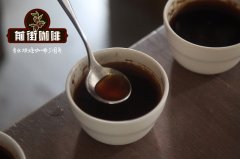Introduction of Coffee knowledge Coffee Bean Variety types and Taste and Flavor

Professional coffee knowledge exchange More coffee bean information Please pay attention to coffee workshop (Weixin Official Accounts cafe_style)
Arabica: premium coffee beans with excellent flavor and aroma
Arabica is a representative variety of Ethiopia, which is also produced in South Africa, Africa, Asian countries and other places, accounting for 70%~75% of the world's coffee production. Arabica is less resistant to pests and diseases, so highland areas are more suitable for cultivation, especially Arabica beans produced in highlands above 1500 meters are of the best quality.
Robusta: Strong acidity and intense taste
Robusta is native to Congo, Africa and accounts for 30% of the world's coffee production. Robusta means "tough," and in fact, this coffee tree is not only resistant to pests and diseases, but can survive in any soil, even in the wild. Therefore, it can also be planted in high temperature areas. It grows fast and is easy to cultivate. It has the advantage of low price. It is mainly used to match beans or make instant coffee. India, Africa, Brazil and other parts of the production of Robusta has a strong sour, high caffeine content, taste more intense.
More recently, Arabusta has been bred with Arabica varieties and has a superior taste and aroma.
Coffee beans
Typica
Tibica is the original species of all Arabica varieties. Tibika is said to have originated in southern Sudan, flourished in Ethiopia, and was finally cultivated for commercial production in Yemen around the 7th century AD. Tibica was brought to the East Indies by the Dutch and was the first coffee variety to arrive in the West Indies, where Gabriel Deckley planted it in French Martinique in 1720.
The ripe fruit of Tibica is red. This variety has relatively low yield and poor disease resistance, but its excellent cup test quality still makes it popular all over the world.
Bourbon
Bourbon is the product of a genetic mutation in the native Tibica species on Reunion Island and is the paternal and even grandparent line of many popular Latin American coffee species, including Kadura, Kaduai, Pakas, New World, and others
species. Bourbon, still popular in Latin America today, traveled further afield to Africa, settling in Rwanda and Burundi. The ripe fruit of Bourbon is mostly red, but there are yellow or orange varieties. Bourbon yields about 20% to 30% more than Tibica; although the flavor is slightly sweeter and sometimes better balanced, the two varieties of coffee are generally very similar.
Catimor
Khatim is a cross between Khadura and Timor-not to be confused with Khadura and Kaduai. This highly resistant plant has the ability to resist coffee leaf rust and was widely cultivated in Latin American countries in the 1980s. Unfortunately, because Timor (also known as Arabusta) is the product of a natural cross between Tibica Arabica and Robusta, although the latter confers disease resistance, the delicate taste of Arabica is lost.
Catuai
Kaduai was bred in Brazil in the 1950s. It is a hybrid of Kadura and New World, with strong disease resistance and high yield. Similar to Kadura, the ripe fruit of Kaduai is naturally divided into red and yellow (I personally prefer the former). Carduai is known for its intense acidity and is a common variety in most Central American countries.
Caturra (English)
In the 1930s, a gene mutation in bourbon was discovered near the Brazilian city of Kadulla, and it was named Kadulla. Kadura is a high-yield, compact plant that is easy to pick, but if grown at lower altitudes, this trait becomes its own worst enemy-coffee becomes so light that the weight of the fruit itself can crush the plant. If grown at high altitudes (above 1200 meters), Kadura's coffee quality and yield are more guaranteed. Kadura is a common name in the coffee belt of Central America.
See varieties.
English Geisha
The slightly lanky fruit and leaves of Guixia are genetic mutants of Tibika and are said to be native to Guixia, a small town in southwestern Ethiopia. In the 1930s, rose seeds were shipped to Tanzania, and in the 1950s to Costa Rica. These two countries are the only significant growers of Rosa outside Panama-although Panama is the best spokesperson for Rosa.
In Panama's high-altitude growing regions, Jamaica Blue Mountain coffee proved itself to be the undisputed coffee variety after its tropical flavor, citrus and tea characteristics. Everyone loves good coffee and sincerely hopes that Guixia can go to other countries.
marago gipe
Malagojpe is thought to be a natural genetic mutation of Tibica, first discovered near Malagojpe (one word short) in Brazil's Bahia region. Malagojippe is known as the chunky coffee bean and is also the paternal variety of Pakamara.
Mundo novo (English)
The New World (also known as Mondo Novo) is a hybrid of Bourbon and Tibica, first discovered in Brazil in the 1940s and still popular with Latin American coffee-producing countries. Its disease resistance and yield were superior to Bourbon and Tibica, but at the expense of flavor complexity.
Due to its high yield and high pest resistance, it is called New Hope and accounts for 40% of all Brazilian varieties. Disadvantages: Plants are too tall to harvest easily.
Pacamara (English name)
Developed by El Salvador in the late 1950s, Pacamara is a hybrid of Pacas and Malagojipe, and is in high demand today. Similar to the marago gipe, it is large-usually twice the size of a standard bourbon bean-but it produces only modest amounts. Pakamala is widely praised for its clean acidity and fresh floral fragrance, and the higher the altitude, the better.
Pacas
Salvatore discovered a natural genetic mutation of bourbon, Pacas, in 1949. Its compact plant withstands conditions at relatively low altitudes and is therefore used to cross with the opposite Malagojipe.
Tix
The Salvadoran Coffee Institute (ISIC) began artificial selection of bourbon plants in 1949, and after 28 years of unremitting efforts, it finally developed a short tix species in 1977, also known as the "improved version of bourbon." Although the Tix variety is relatively low in yield, its long breeding process makes it very attractive in terms of complex flavors and quite full in taste. Farmers in El Salvador, Honduras, and Guatemala are keen to use the variety to improve their coffee.
SL–28
SL-28 stands for Scott Laboratories, a technology company hired by the Kenyan government since the 1930s to identify the best local coffee varieties for large-scale cultivation. SL-28 has become a benchmark variety in several growing areas of Kenya, partly due to its strong blackcurrant flavor. SL-28 is suitable for growing at high altitudes.
SL–34
SL-34 is slightly inferior (but by no means inferior) to its sister SL-28, but it is equally acidic and has a berry flavor. SL-34 performed better than SL-28 at lower altitudes (although it had a higher number), and it was also more resistant to heavy rain if planted at higher altitudes, so people tended to grow it at higher altitudes. But SL-28 and SL-34 are both highly susceptible to coffee leaf rust.
Vera Saki
The dwarf variety is a genetic mutation of bourbon, first discovered in Salchi, Costa Rica. Its branches form steep angles to the trunk, and its leaves are an interesting bronze among the plain green leaves. Vera Saki's fruity flavor is excellent. Besides, its yield is very high and its disease resistance is reasonable.
Important Notice :
前街咖啡 FrontStreet Coffee has moved to new addredd:
FrontStreet Coffee Address: 315,Donghua East Road,GuangZhou
Tel:020 38364473
- Prev

What is Rose Summer Village Lot43? How charming is the coffee kissed by angels?
Professional coffee knowledge exchange more information about coffee beans Please follow the coffee workshop (Wechat official account cafe_style) the species of Geisha was discovered in the Rosy Forest of Ethiopia in 1931 and sent to the Coffee Research Institute in Kenya. It was introduced to Uganda and Tanzania in 1936 and Costa Rica in 1953.
- Next

What kinds of Coffee trees are planted | Coffee flavor characteristics of coffee species
Professional coffee knowledge exchange more coffee bean information please follow the coffee workshop (Wechat official account cafe_style) Arabica (Arabica): first-class flavor and aroma of premium coffee beans Arabica is a representative variety of origin in Ethiopia, in South Africa, Africa, Asia and other countries also have production, accounting for 70% / 75% of the world's coffee production. Arabica is concerned about illness.
Related
- Detailed explanation of Jadeite planting Land in Panamanian Jadeite Manor introduction to the grading system of Jadeite competitive bidding, Red bid, Green bid and Rose Summer
- Story of Coffee planting in Brenka region of Costa Rica Stonehenge Manor anaerobic heavy honey treatment of flavor mouth
- What's on the barrel of Blue Mountain Coffee beans?
- Can American coffee also pull flowers? How to use hot American style to pull out a good-looking pattern?
- Can you make a cold extract with coffee beans? What is the right proportion for cold-extracted coffee formula?
- Indonesian PWN Gold Mandrine Coffee Origin Features Flavor How to Chong? Mandolin coffee is American.
- A brief introduction to the flavor characteristics of Brazilian yellow bourbon coffee beans
- What is the effect of different water quality on the flavor of cold-extracted coffee? What kind of water is best for brewing coffee?
- Why do you think of Rose Summer whenever you mention Panamanian coffee?
- Introduction to the characteristics of authentic blue mountain coffee bean producing areas? What is the CIB Coffee Authority in Jamaica?

